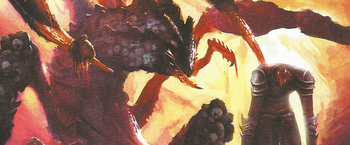Varakith are large insectoids with sharp legs that speak through "songs".
Background[ | ]
A varakith is a vaguely insect-like creature, 10 ft. long, with multiple legs that end in tips as sharp as spears. It uses these lances to skewer its enemies and drain them of blood, after which the creature adds them to its own body to serve as armor.
It came as a great surprise when the scholar Niomedes discovered that the strange noises the varakith make are actually songs and have meaning to them. Until that point, they were just assumed to be near-mindless beasts. Varakith "speak" (or rather, "sing") by rubbing two of their legs together, which then produces a trilling sound. The song that Niomedes translated went as follows:
We fight and crush Gnash and drink The foe at our heels will be our bread The foe at our heels feeds victories yet to come Stronger today, stronger tomorrow We fight We crush We gnash
The discovery that the varakith are intelligent warmed no one's heart, for the creatures have a dark and bloodthirsty spirit with little respect for others.[1]
Abilities and Traits[ | ]
Motive:[ | ]
Hungers for blood; lusts after combat
Environment:[ | ]
Varakith dwell alone or in pairs in any temperate or warmer region. They make nests underground.
Health:[ | ]
25
Damage Inflicted:[ | ]
6 points
Armor:[ | ]
4
Movement:[ | ]
Short
Modifications:[ | ]
Resists poisons or disease at level 6
Combat:[ | ]
In combat, a varakith attacks with is spear-like legs. Those struck by a leg must make a Speed defense roll or be kncked prone and held immobile. Only creatures that are smaller than the varakith can be held immobile on this way. A varakith can hold up to three small victims immobile at once.
Immobilized victims lose their next turn. On the varakith's next turn, it can automatically bite the held creature, dealing 4 points of damage and draining its blood - and in addition to the bite, the varakith still takes its normal action for that turn. This action could be to attack the immobilized victim with another spear-leg ( the victim's defense roll is hindered by two steps: one step because the victim is prone and another because they're held down).
Once they can act, victims can try to free themselves by making a Might-based roll. Failure ensures that the varakithgets another bite in.
A slain creature is tossed onto the varakith's back, where the body is caught on spines and hooks. Each corpse adds 1 to the varakith's Armor for 28 hours.
Interaction:[ | ]
Varakith haven't any respect for other creatures, although one that proves itself in combat might be worth speaking to if communication can be established. Varakith see the world as one big gladiatorial arena in which they must constantly prove themselves. Even a respected combatant is till a foe to be overcome eventually - long-term alliance isn't possible. However, varakith aren't particularly devious or duplicitous about their mindset. They make their feelings well known.
Use:[ | ]
Varakith are excellent foes for PCs that are exploring underground areas, and having these monstrous things turn out to be fairly intelligent is also a nice twist. Consider a scenario in which a young man hires the PCs to find his brother - a tough and skilled glaive - who disappeared while exploring a cave in the hills. Only after long searches do the characters discover that the brother's corpse now adorns the back of a vicious varakith.
Loot:[ | ]
The bodies that the varakith wear as armor usually have some useful equipment and probably even a cypher.[2]
Miscellaneous[ | ]
Varakith typically war against subterranean communities of humans, such as those in Deep Vormask.[3]
References[ | ]
- ↑ Cook, Monte, et al. “Creatures.” Numenera Discovery, Monte Cook Games, LLP, 2018, pp. 258. Numenera. ISBN 978-1-939979-45-2
- ↑ Cook, Monte, et al. “Creatures.” Numenera Discovery, Monte Cook Games, LLP, 2018, pp. 258. Numenera. ISBN 978-1-939979-45-2
- ↑ Cook, Monte, et al. “Creatures.” Numenera Discovery, Monte Cook Games, LLP, 2018, pp. 258. Numenera. ISBN 978-1-939979-45-2

